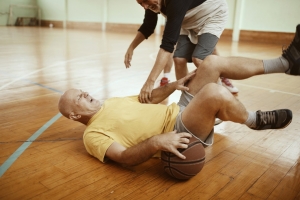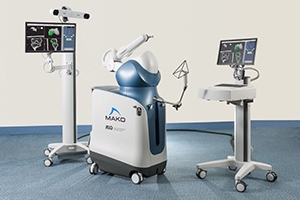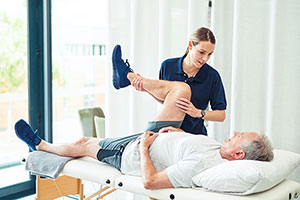The hips consist of two main parts: the ball at the end of the femur and the socket in the pelvis. Together, they form a ball-and-socket joint, and they are secured by several other components, such as a joint capsule, ligaments, tendons, and various muscles in the spine, groin, and buttocks.
All of these keep the hip stable and allow a full range of motion. When healthy, it would take significant force to disrupt this stability, such as a blow during contact sports or falling from a considerable height.
As the largest ball-and-socket joint and one of the widest parts of the skeleton, the hips are more susceptible to bearing the impact of a fall. As such, trauma is dealt to the hips, resulting in different types of injuries.
Below, we delve into the most common injuries from falling on your hip and the various treatment options available.
Most Common Hip Injuries From A Fall
Hip Bursitis
Bursitis is an inflammation in the tiny, jelly-like sacs located throughout the body called bursae. These sacs contain fluid that helps reduce friction between bones and soft tissues. This is caused by severe trauma resulting from banging the hip on a hard surface or falling on the outside of the hip, causing the bursa to fill with blood.
Two types of bursitis can occur in the hips when two different bursae become irritated and inflamed. These are:
- Trochanteric Bursitis - caused by an inflammation in the bursa covering the bony part of the hip bone called the greater trochanter.
- Iliopsoas Bursa - occurs when the inflammation is located in the bursa near the groin area.
Symptoms:
- Localized pain on the outside area of the hip and thigh or in the buttocks.
- Pain that occurs when lying on the affected side.
- Pain that occurs when applying pressure on or outside of the hip.
- Pain that intensifies when performing even minor activities like getting up from a chair or walking up the stairs.
Hip Labral Tear
A labral tear in the hip is an injury that occurs in the labrum. This is a cup-shaped cartilage rim that lines the hip joint's socket part and keeps the joint aligned during motion. It also helps keep the joint fluid in place to ensure frictionless movement.
Some labral tears can result from gradual wear on the labrum due to old age or excessive use. But in cases of trauma, a section of the labrum can tear away from the socket bone, causing pain, reduced range of motion, and a sensation of locking up in the hips.
Symptoms:
- Pain in the groin, buttocks, or hips that intensifies during periods of activity
- Limited range of motion in the hips or a feeling of stiffness
- The sensation of clicking or locking in the hip joint during motion
Hip Dislocation
Hip dislocation is one of the most common hip injuries from a fall. This occurs when the impact of falling from a significant height deals excessive force that causes the femur to dislodge from the pelvis, the extent of which depends on the gravity of the force dealt.
Symptoms:
- Acute to severe pain
- Muscle spasms
- Swelling or discoloration at the hip joint
- Odd rotation in the leg
- Inability to bear weight on or move the leg
- Loss of feeling in the foot, legs, or hip
- Visible displacement of the hips
Hip Fracture
Hip fractures are breaks in the upper portion of the femur. They are one of the most common hip injuries from falling among elderly patients with weaker bones due to osteoporosis. But they can also occur in younger patients due to severe trauma caused by vehicle collisions or falls from a considerable height.
Symptoms:
- Intense pain in the groin or hip
- Inability to immediately get up or walk after a fall
- Inability to place any weight on the leg at the side of the injured hip
- Presence of swelling and bruising at and around the area of the hip
- The leg appears to be shorter at the side of the injured hip
- Visible displacement of the hip or leg
Hip Strain
Hip strains occur when muscles supporting the hip joint are stretched beyond their limits to the point of tearing. They are common sports-related hip injuries and can result from overstretching, insufficient warm-up before activity, direct blow during contact sports, or a fall. Hip strains can also be caused by the weakening of the muscle or tendon due to overuse due to repetitive movements.
Symptoms:
- Tenderness in the affected area
- Limited range of motion
- Swelling around the hip area
- Muscle weakness along the hips
- Onset of pain during movement as the muscles are used
Snapping Hip Syndrome
Snapping hip syndrome is a condition that is characterized by the audible snapping sound or snapping sensation felt around the hip area. For some people, the snapping sound is the only symptom that manifests, which may be considered a slight annoyance. However, pain can also develop as a result of falling, which dramatically limits the range of motion in the joint and impedes performance as an athlete or dancer.
Symptoms:
- Snapping sensation or sound in the back, front, or side of the leg during movement
- A feeling of tightness in the hip
- Swelling
- Weakness in the hip
- Limited range of motion
How to Treat Hip Injury From Falling
Pain experienced after falling on your hip can range from mild to extremely painful, depending on the extent of the injuries sustained. For milder symptoms, applying ice on the affected area, having plenty of rest, and stopping all movement can help alleviate some pain.
However, this only applies to minor injuries. To eliminate the possibility of permanent damage, it is still vital to seek emergency medical treatment after a fall to ensure that your injury is given proper care and ensure a fast and complete recovery.
For Hip Injuries From Falling and Sports-Related Hip Injuries, Seek Treatment At The American Hip Institute
After a fall, it’s normal to want to know how to treat hip injury from falling right away to relieve some of the pain. However, home remedies should not replace expert medical care to properly diagnose your injury and develop the right plan that can lead to your quick recovery.
The American Hip Institute provides innovative hip treatment solutions to properly care for hip injuries sustained after a fall. After determining the extent of your injuries, our orthopedic specialists will determine the best course of action and help you develop a personalized recovery plan. Contact us today to schedule your appointment.




